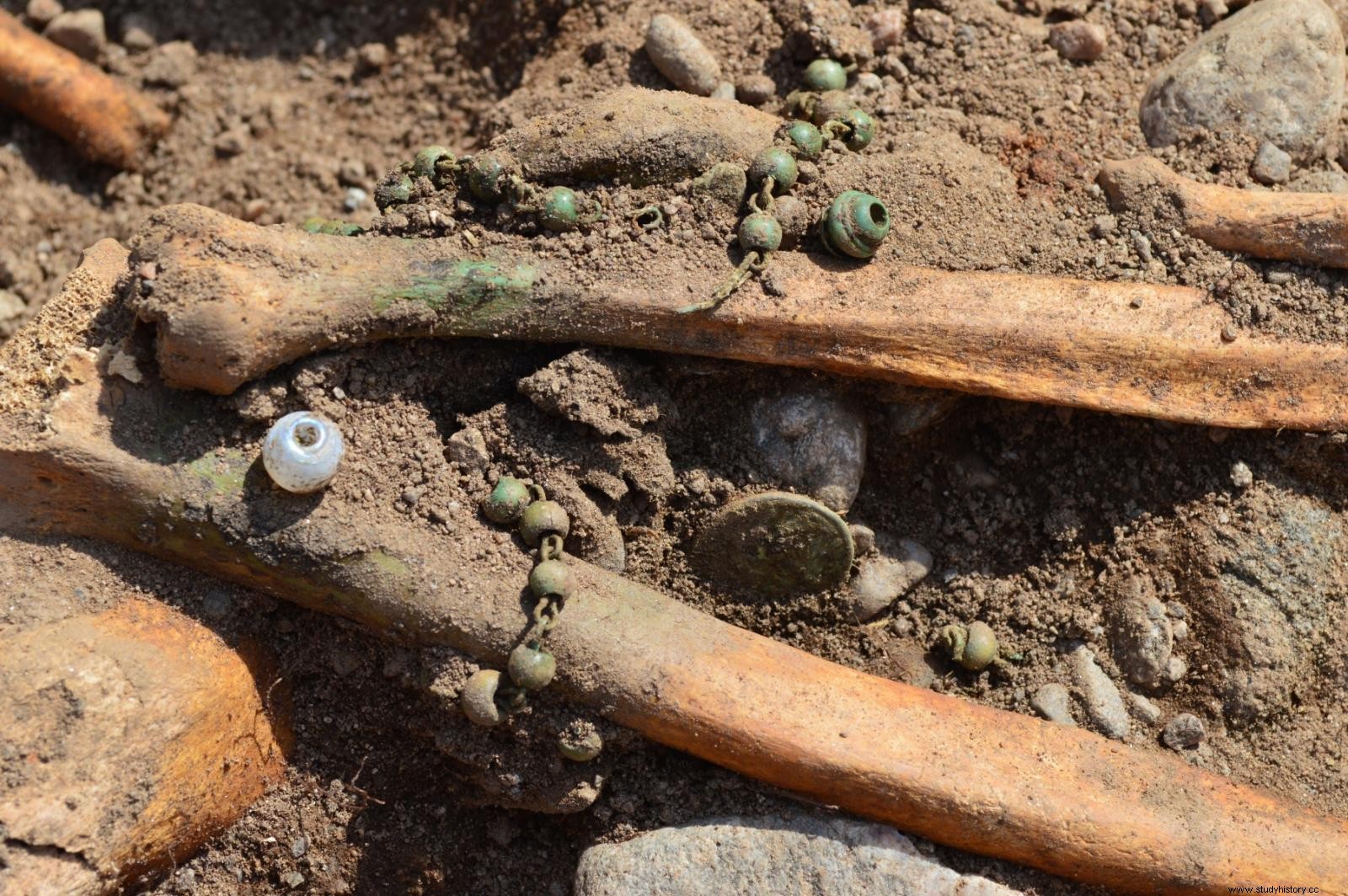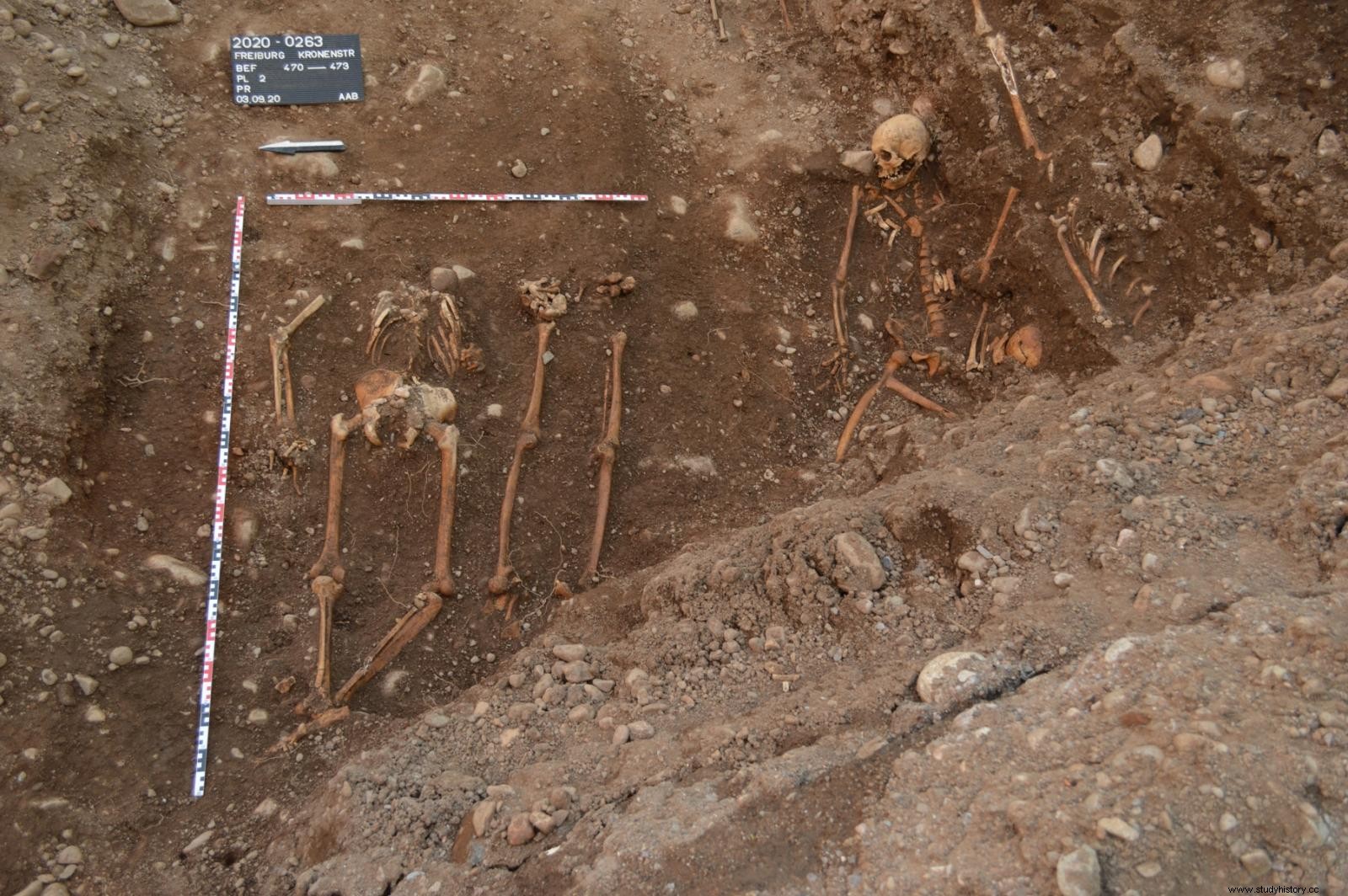In the Middle Ages, being afflicted with an incurable infectious disease meant solitary confinement forever. Leprosy, syphilis or tuberculosis thus automatically condemned to oblivion. The discovery of 400 skeletons on the site of the former cemetery of a medieval leprosarium in Freiburg im Breisgau (in Germany) will therefore make it possible to learn more about several infectious diseases which have plagued the European continent, and to better care for people who are now carriers elsewhere in the world.

In Freiburg im Breisgau (Germany), at number 21 Kronenstrasse, the entrance area of a future underground car park is combed through to exhume bodies from a medieval leper cemetery.
In the Middle Ages, people with contagious diseases were isolated in hospices located outside the cities, where they spent the rest of their lives. Once they entered these places, they had, so to speak, already joined the realm of the dead. Putting an end to this age-old oblivion, rescue excavations carried out on the site of a former leper colony in the German city of Freiburg im Breisgau, at the foot of the Black Forest, will undoubtedly make it possible to learn more about some of these patients banished from society and about the diseases they carried.
400 skeletons exhumed in the cemetery of a leper colony in Freiburg im Breisgau
In May 2020, at Kronenstrasse 21, earthworks in anticipation of the construction of an underground car park had to be quickly halted upon the discovery of a human skull; the archaeologists of the Office for the Protection of Historic Monuments (LAD) in Stuttgart expected it, because they knew that at this address stood a leper colony in the Middle Ages.
Carried out in two stages during the years 2020 and 2021, salvage excavations made it possible to exhume a total of 400 skeletons in two separate areas, corresponding to two phases of use of the site. Arranged in rows and all oriented east-west, the oldest tombs date from the medieval period and house the inhabitants of the leper colony. In a second area, the bodies were buried pell-mell. Bronze buttons and remnants of uniforms identify them as soldiers; as archaeologists explain in a press release, they are certainly French troops who fell during the siege of the city in 1744, during the War of Austrian Succession.

The dead were buried with prayer beads in the most recent area. © Jana Noll, AAB Archäologie / Landesamt für Denkmalpflege im Regierungspräsidium Stuttgart
Sick people with incurable diseases
A first anthropological analysis revealed that the people buried were almost exclusively men, and that the vast majority of them (90%) showed signs of infectious diseases in the bones and jaws:leprosy for 60 % of bodies, but also syphilis, tuberculosis and meningitis; signs of rickets and malnutrition were also detected.
There was no known cure for leprosy, a chronic infectious disease caused by the bacterium Mycobacterium lepra. e, which first appeared in Europe in the early Middle Ages. As for syphilis, analyzes of recovered bodies could provide valuable information, as there is uncertainty about when this sexually transmitted bacterial infection began to show up on the European continent. Since certain bone lesions symptomatic of syphilis are very similar to those caused by leprosy, it has been possible to confuse the two diseases and isolate syphilitic patients as lepers in the leprosy.
The cemetery dates from 1256
Then located outside Freiburg, some distance south of the city gates, the Kronenstrasse leper colony is mentioned for the first time in the texts in 1251. Scholars know about it that it received a chaplain and a cemetery in 1256, and that a new chapel was built in 1268. Historical illustrations provide an idea of the establishment, which consisted of residential buildings for the sick, a commissary, a chapel, a cemetery and surrounding land. According to the texts, the leper colony was destroyed on December 29, 1632, during the Thirty Years' War, burned by the Swedish army.
The cemetery would have more than 2,000 graves in all
Since there is no plan of the construction, the archaeologists carried out a geophysical study to determine which buildings once stood on the excavation site. They thus saw taking shape at a depth of between 50 cm and 1.6 meters parts of buildings:the cemetery and other foundations that could correspond to the chapel. Since only 10% of its original surface was identified during the excavations - the rest of the cemetery having been buried since the end of the 19th century under apartment buildings - the archaeologist of the Stuttgart LAD Bertram Jenisch estimates that 2,000 the number of graves that have been buried there during the 376 years of its use. And since in the excavated part only men were found, it would seem that its construction respects the separation between men and women which was current in the hospice.

The graves in the oldest area were neatly lined up. © Jana Noll, AAB Archeology / LAD Stuttgart
The living already dead
The leprosy houses for contagious people (leprosariums and other lazarettos for plague victims) were built at the gates of the city, at a maximum distance of 10 km. The sick, whatever their social status and their fortune, lost practically all their rights and entered them after having received the sacraments. Which meant they were already considered dead. They essentially lived on donations and begging.
In Germany, they were called "good people" (Gutleut ), because we thought that by lavishing benefits on them, we could go to heaven. This is also the reason why hospices (Gutleuthäuser ) were on busy country roads; the one to the south of Freiburg led to Basle. According to Bertram Jenisch's research, Freiburg, which was the largest city in the Brisgau region, located southwest of the current Land of Baden-Württemberg, had at least three leper colonies in 1500. The one located on the road to Basel is the oldest; the others were built to the north of the city, these locations being intended to protect the population from the "bad air" that could emerge.
The most explored leper cemetery in Germany
Insofar as many leper cemeteries have already been found in Germany, the site of Freiburg is not unique, but it stands out for its great archaeological value. Because its soil has been particularly well preserved there, sheltered from the air, it is now the most explored leper cemetery in the country, and certainly the most useful. Because on these forgotten bodies, it will not only be possible to recognize the symptoms of leprosy, but also to determine the age at which the people buried died and the causes of their death. These analyzes on the bones will be carried out in Konstanz, while the LAD in Stuttgart will examine the objects found with the deceased:the nails of the coffins, the amulets and the remains of rosaries that have accompanied them until now.
Important information for the treatment of leprosy
In order to be able to extract as much information as possible from these preserved skeletons, archaeologists also took soil samples from the stomach area; they hope to find traces of disease there by analyzing the remains of intestinal bacteria. Several international research institutes have already declared their interest in the results of these analyses, because research on the graves of lepers is rich in teaching for the treatment of leprosy. The disease certainly disappeared 300 years ago in Germany, but it continues to plague many countries, in the southern hemisphere in particular, whereas today it can be treated with antibiotics and chemotherapy.
